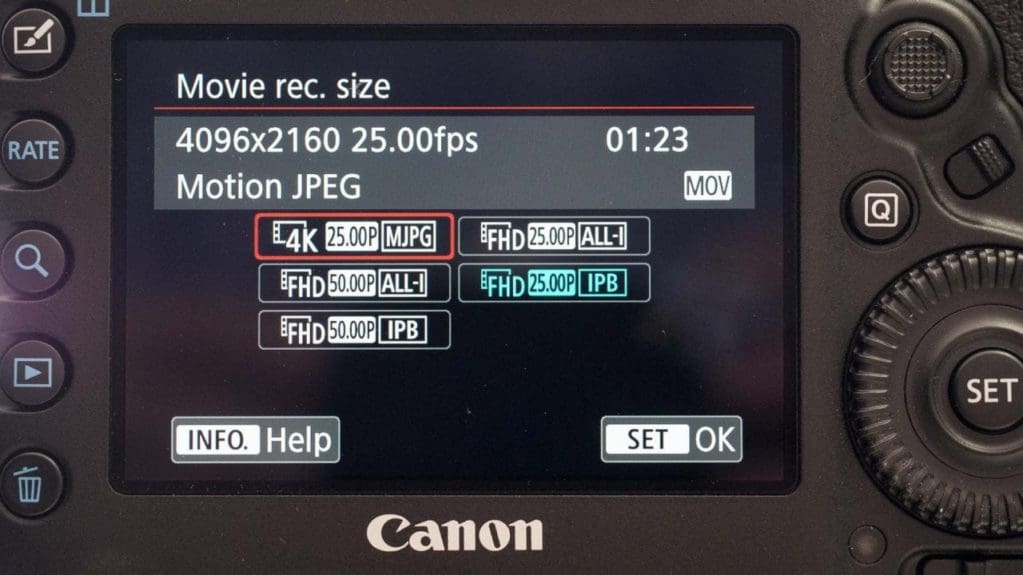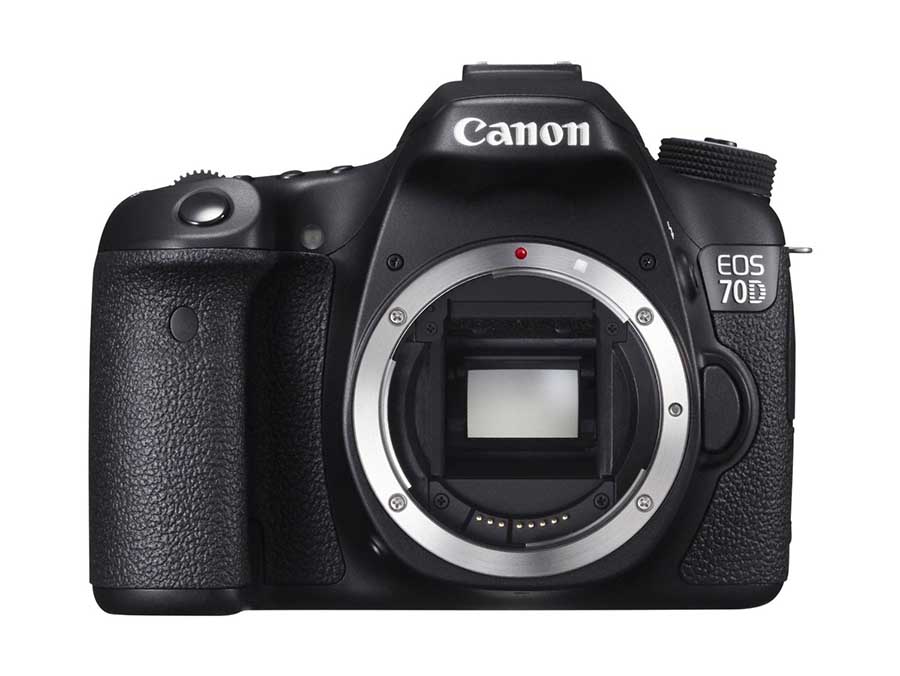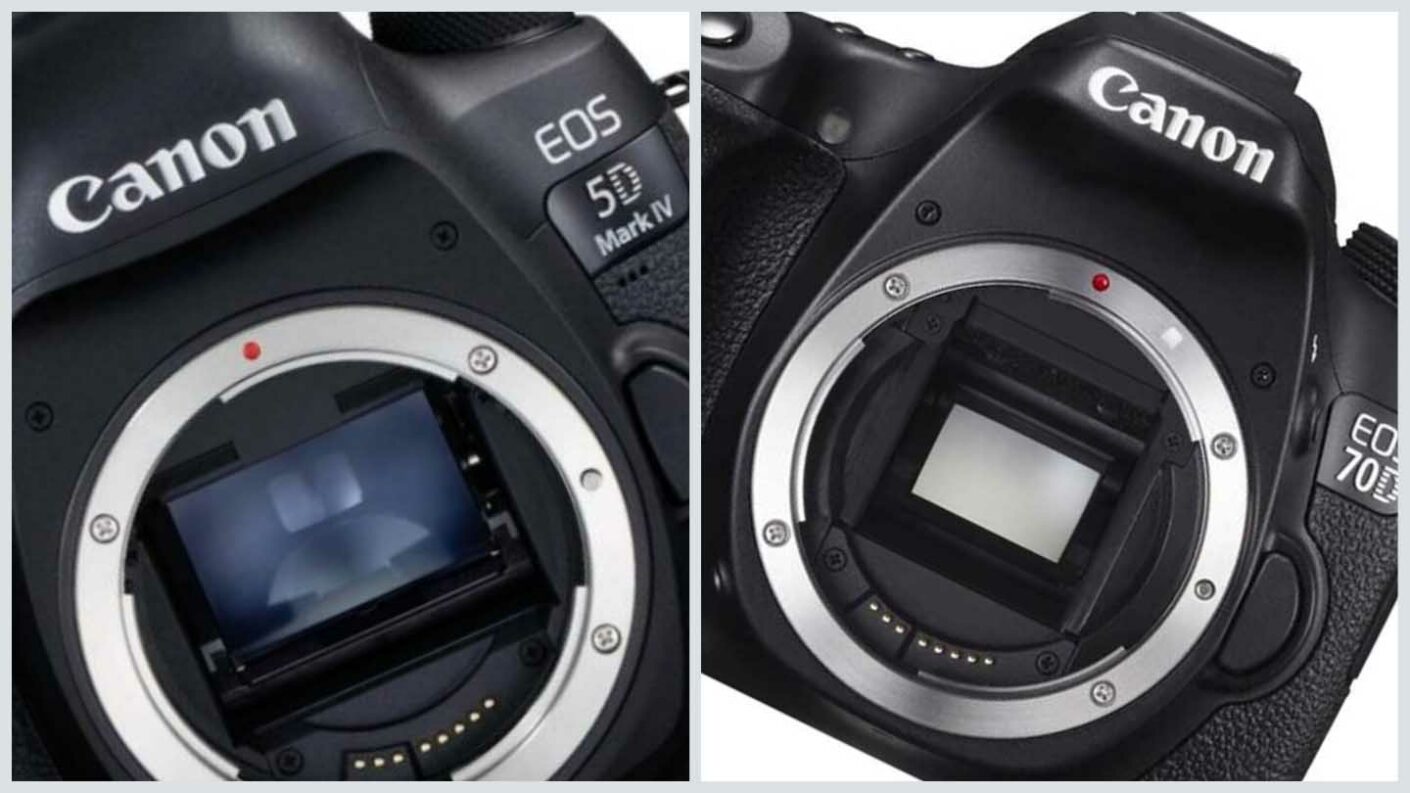The Canon EOS 70D dates from July 2013 and it’s been tremendously successful amongst its target market of enthusiast photographers. However, by now, many of those users are likely to be thinking of moving on to another camera and the Canon EOS 5D Mark IV makes a likely candidate for an upgrade. In this post we’ll take a look at the key differences between the two DSLR cameras to see how they compare and help you decide whether the Canon 5D IV is the camera for you.
Sensor
- Canon EOS 5D Mark IV: 30.4 full-frame (36 x 24mm) CMOS
- Canon EOS 70D: 20.2Mp APS-C format (22.5 x 15.0mm) CMOS
This is one of the biggest differences between the Canon 5D Mark IV and the Canon 70D, the 5D Mark IV is a full-frame camera while the 70D has an APS-C format sensor. In addition, the 5D IV makes a jump of almost 10Mp in resolution in comparison with the 70D.
Even though the 5D IV has more pixels on its sensor, the larger size of the chip means that each of the photosites is bigger than those on the 70D’s sensor. That’s good news for image quality as larger pixels gather more light and require less gain to be applied to the image signal.
As well as producing better quality images, the larger sensor of the 5D Mark IV brings the ability to restrict depth of field more at any give aperture. That means you can blur backgrounds more effectively but you need to consider the focus and aperture selection carefully when photographing subjects that require extensive depth of field.

Lens mount
- Canon EOS 5D Mark IV: Canon EF
- Canon EOS 70D: Canon EF-S
Because of their difference in sensor size, the Canon 5D Mark IV and 70D have different lens mounts. The Canon 5D IV has Canon’s EF mount and it can only accept full-frame lenses with that mount. The 70D, however, has the EF-S mount and it can accept full-frame EF mount or APS-C format EF-S mount lenses.
Consequently, if you upgrade from the Canon 70D to the Canon 5D Mark IV, you may need to invest in new lenses as any EF-S optics are not compatible.
Autofocus system
- Canon EOS 5D Mark IV: 61 Point with up to 41 cross-type AF points inc 5 dual cross-type at f/2.8 and 61 points / 21 cross-type AF points at f/8
- Canon EOS 70D: 19 cross-type AF points (extra sensitivity at f/2.8 at centre)
The 70D’s 19-point AF system is a good performer but the 5D Mark IV’s is in another league. Having 42 more AF points means that there’s more likely to be a point where you need one, so you’re less likely to need to focus and recompose. Also, the camera is more able to follow a moving subject around the frame as there are smaller gaps between the AF points.
Cross-type points and dual cross-type points are also more sensitive than the regular linear points, which means that the 5D Mark IV is better at picking up some subjects.
Sensitivity range
- Canon EOS 5D Mark IV: ISO 100-32000 expandable to ISO 50-102400
- Canon EOS 70D: ISO 100-12800 expandable to ISO 25600
Thanks to the larger pixels and the Digic 6+ (rather than Digic 5+) processing engine, the 5D Mark IV has a wider sensitivity range than the 70D. Of course, you may not want to use the upper ISO settings that often, but the 5D Mark IV also produces cleaner images in the mid-to-high ISO range, which is handy when light levels fall and you need to use a fast shutter speed.
Viewfinder
- Canon EOS 5D Mark IV: Pentaprism showing 100%
- Canon EOS 70D: Pentaprism showing 98%
As they’re DSLRs, the Canon5D Mark IV and 70D both have optical viewfinders. The most significant difference between them is that the 5D Mark IV’s shows the full scene so there are no surprises around the edges of the frame. The Canon 70D’s viewfinder only shows 98%, which means that there could be objects at the edge of the image that you were unable to see when you were composing the shot. The simple solution is to crop the image, but with the 5D Mark IV, you should always get the composition you expect.
Screen
- Canon EOS 5D Mark IV: 3.2-inch 1,620,000-dot Clear View II LCD
- Canon EOS 70D: Vari-angle 3-inch 1.040,000-dot Clear View II TFT
While the 5D Mark IV’s screen is larger and higher resolution than the 70D’s, it’s fixed rather than articulating like the 70D’s. Both screens are touch-sensitive and offer an intuitive way of controlling the camera, but if you’re used to being able to flip out the screen and angle it to give a clear view in Live View mode, swapping to a fixed screen may come as a shock.

Flash
- Canon EOS 5D Mark IV: External only, PC terminal
- Canon EOS 70D: GN12 @ ISO 100, no PC terminal
While you usually get better results using flash off-camera, it can be handy to have a pop-up flash built-in. Sadly, the Canon 5D Mark IV doesn’t have a built-in flash but it does have a PC terminal for connecting a light via a cable. Both cameras also have a hotshoe which enables a flashgun to be used on the camera or it can be used to mount a trigger for an off-camera flash system.
Video
- Canon EOS 5D Mark IV: 4K DCI at up to 30fps with 1.27x crop
- Canon EOS 70D: Full HD (1920 x 1080) at up to 30fps
It’s another clear win for the Canon 5D Mark IV as it can shoot 4K video whereas the 70D can only muster Full HD video.
At launch the 5D Mark IV was subject to a dramatic crop in 4K video mode but a firmware upgraded reduced this to 1.27x, which is much more manageable.
Both cameras have a 3.5mm port for connecting an external microphone, but only the 5D IV has a socket for connecting headphones to allow you to monitor the audio.
Continuous shooting
- Canon EOS 5D Mark IV: 7fps with full AF/AE for up to an unlimited number of Jpegs or 21 raw files
- Canon EOS 70D: 7fps for up to 65 Jpegs or 16 raw files
There’s no difference in the maximum shooting rate of the 5D Mark IV and 70D, but the 5D Mark IV can shoot Jpegs at 7fps for quite a bit longer than the 70D. That could be very useful for a developing situation and unpredictable action.
The burst depth when shooting raw files is similar, with only 5 images separating them, but the 5D Mark IV still comes out on top.
Build
- Canon EOS 5D Mark IV: 150.7 x 116.4 x 75.9mm, 800g body only
- Canon EOS 70D: 139.0 x 104.3 x 78.5mm, 755g with battery and memory card
As you can see from the dimensions, the 5D Mark IV is significantly bigger and heavier than the 70D. That may take some getting used to, especially if you have to buy a few full-frame lenses to go with it, but many photographers prefer the extra room that this affords their hands. It also means the 5D IV feels better balanced with long lenses.
Both cameras are weather-sealed.

Should I sell My Canon EOS 70D?
While stepping up to the Canon 5D Mark IV means that your kit is bigger and heavier, and you lose the vari-angle screen, the image quality is better and you’re likely to notice that your images look cleaner when you shoot in low light. The autofocus system is also more versatile and you can expect to get a higher hit-rate when shooting moving subjects.
The Canon EOS 5D Mark IV is a popular camera with experienced enthusiast and professional photographers alike and it makes a great upgrade from the Canon EOS 70D.
Sponsored: Thinking of selling your Canon EOS 70D to upgrade? Get a free instant quote from MPB and find out what your kit is worth. Selling your gear to MPB is easy and secure. Plus get free doorstep pickup and super-fast payment. We’re loved and trusted by more than 250,000 visual storytellers around the world and we’re rated excellent with five stars on Trustpilot. Buy. Sell. Trade. Create.





Don’t understand why entirely two different cameras used for different purposes are being compated!
But know this for sure that Canon crippled the 70D deliberately.
Thank you, I have a 70d and thinking of buying a 5d mark 2. Very helpful!!!